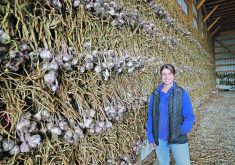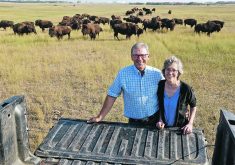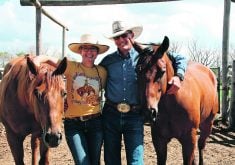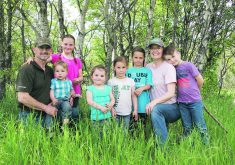REDWATER, Alta. — When Marc and Hinke Therrien met in a dairy production class at the University of Alberta, they knew farming was in their future.
They thought they would become dairy farmers but life offered them a different path in turkey farming near Redwater, Alta.
Their innovative work in the poultry business earned them the title of Alberta’s Outstanding Young Farmers this spring.
This opportunity expands their network within the farming community where they can meet a diversity of producers with new ideas.
Read Also

Nutritious pork packed with vitamins, essential minerals
Recipes for pork
“We decided to go with it because they are always such positive people. Because they are outstanding, they are out of the box thinkers, they are open to teaching you. It is just a good crew of people to hang out with,” said Hinke.
While upgrading the farm, they also had time to start a family, which includes three daughters: Annelies, four, Emilie, three and Natalie, one.
Hinke was born in the Netherlands and her family settled at Ponoka, Alta., where they ran a dairy farm that was converted to a turkey operation in 2000. Her father also owned the operation at Redwater.
Marc was a city person but wanted to farm from the time he was a youngster helping on his grandparents’ dairy. His father worked with Farm Credit Canada where his career took the family to St. Albert, Alta., from Ottawa.
“I proved a city kid can be a farmer. I always wanted to be a farmer,” he said.
After graduation, they both went to work for feed companies, with Marc serving as a poultry feed sales representative.
“I never realized how much fun it was working with poultry until I sold feed. That is where the passion started and now we are turkey farmers,” he said.
Marc got a job managing a poultry farm and Hinke worked at a different farm. They bought the Redwater farm about three years ago and added a small broiler operation.
The farm raises tom turkeys that are grown to about 15 kilograms in a 19-week cycle. They are then sent for further processing.
In 2015, they produced more than 1,650,000 kg of turkey in their barns that cover about three acres.
They like to try new technology and innovation.
After a fire that destroyed 10,000 birds in two barns several years ago, they rebuilt and installed a more welfare friendly system that is computer controlled and connected to a smart phone that rings when temperature, ventilation, feed or water supplies need attention.
“We are always trying new things. This past few months, we are trying a new lighting program so we are always very keen to try new experiments,” he said.
Turkeys take special management.
“With turkeys, you have to manage for the unknown because they are so unpredictable. You have to have your management at a high level.”
The birds must be monitored regularly to make sure they keep drinking, eating and do not have accidents.
“It is very critical that you plan for the unexpected and make sure everything goes right. We really work on a good biosecurity program, disinfection and rotate everything,” he said.
Bird welfare is important because they strive to have healthy birds and low mortality rates.
“We have a bit of a unique system in that we have lower stress on our birds. We put in enrichment pieces in the barns to keep the environment above and beyond,” Hinke said.
She came up with the idea of putting large square straw bales in the barn. There is one bale per every 1,000 birds that gives them a place to explore and perch.
In the future, they hope to diversify and expand their 80 acres to grow more of their own feed, but now try to buy their feed and other supplies locally.
The region includes heavy industrial development and the land is considered marginal and land prices are high. A half section sold for $2.3 million recently.
They have one employee but labour is also a challenge.
“With the upgrader right beside us, it is hard to find good people who want to work in agriculture,” Hinke said.
“Everybody thinks you should pay oil field money,” added Marc.
When they first arrived at this site, they developed an environmental farm plan.
Their water is delivered in a pipeline from Edmonton so the household and barns receive treated city water. The water is further treated and goes into storage tanks in case there is a delivery failure.
When they approach market size, each bird is drinking almost one litre per day. The Therriens notice higher usage during the summer when 60,000 birds are drawing on the system.
Their barns are heated with natural gas that has become a major expense that increased with the provincial carbon tax this year. This winter, their natural gas bill went up 18 percent.
They are hoping the poultry sector can either pass on the added cost or get an exemption or rebate to help control expenses.
“For our farm alone, it could be $15,000 to $20,000 a year in extra costs,” Marc said.
They got some help when they installed LED lighting, but there are limited subsidies available for energy efficient systems.
The Therriens fear the disconnect many urbanites have with agriculture may spill over to government where there is not enough understanding about the business so they are interested in reaching out to the public.
They would like to have a barn with viewing areas to show what happens on a turkey farm.
Hinke is also involved with the university doing consumer education and classroom agriculture programs.
“We are very much an open book. If you want to come see, come see,” she said.


















